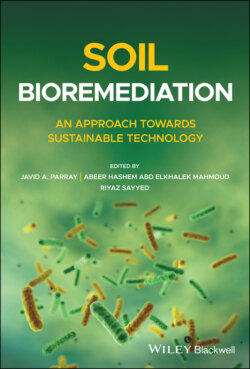Читать книгу Soil Bioremediation - Группа авторов - Страница 31
2.5.1 Microbial Remediation
ОглавлениеThe use of microbes such as bacteria and fungi for soil rejuvenation is a form of environmental remediation. The objective of microbial remediation is to remove soil contaminants and pollutants [107]. Though the industrial use of microbes for removing contaminants goes back only three decades, microbes, aerobes, anaerobes, and facultative anaerobes have been contributing to soil improvement for billions of years. They help with N‐fixation, limiting growth of plant pathogens, and the decomposition of heavy metals, pesticides, and hydrocarbons in the soil. The microbial flora is nourished by the contaminants, degrading them for energy and reproduction. Microbial remediation can be divided into three grades:
Natural attenuation: The process takes place naturally with indigenous soil microorganisms.
Biostimulation: The natural process receives external help in the form of nutrients, moisture, and an ideal pH for the microorganisms.
Bioaugmentation: This involves the use of externally introduced microorganisms, which is the case in situations such as oil spills where the naturally occurring microbes may die out because of the intensity of the contamination [108].
Rhizofiltration: Phytofiltration is used to inhibit organic pollutants in wastewater and surface water from mixing with water streams or groundwater using plants for filtration purpose, as they can absorb or adsorb the pollutants [109]. Phytofiltration can also be: rhizofiltration in which plant roots are used; blastofiltration in which seedlings are utilized; and caulofiltration that uses excised plant shoots) [110]. Due to phytofiltration, the movement of contaminants in the soil is minimized [111]. Phytofiltration is defined as the use of plants, both terrestrial and aquatic to absorb, concentrate, and precipitate contaminants from polluted aqueous sources with low contaminant concentration in their roots. Rhizofiltration can partially treat industrial discharge, agricultural runoff, or acid mine drainage. It can be used for lead, cadmium, copper, nickel, zinc, and chromium that are primarily retained within the roots [4]. The advantages of rhizofiltration include its ability to be used in in‐situ or ex‐situ applications and species other than hyperaccumulators can also be used. Plants like sunflower, Indian mustard, tobacco, rye, spinach, and corn have been studied for their ability to remove lead from effluent, with sunflowers having the greatest ability. Indian mustard has proven to be effective in removing a wide concentration range of lead (4–500 mg/l). This technology has been tested in the field with Uranium contaminated water at concentrations of 21–874 μg/l; the treated U‐concentration reported by studies was <20 μg/l before discharge into the environment. The use of some metal accumulator aquatic plants species, both living and dead, and constructed wetlands for the removal of heavy metals from industrial wastewater has gained considerable interest [112]. Aquatic plants and microorganisms can remove metals from water through processes of biosorption and metabolism‐dependent bioaccumulation. The use of dead or dried aquatic plants, for metal removal as a simple biosorbent material has advantages in its high efficiency including minimization of the volume of chemical and/or biological sludge, no nutrient requirements, low cost, conservation, transport, handling, and metal recovery [113–116].
